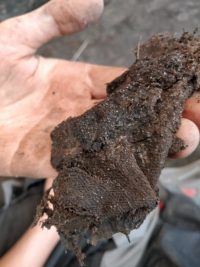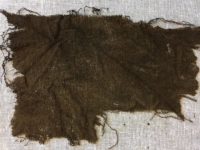Excavations in the historic center of Ribe, the oldest town in Denmark and the hub of maritime trade network that operated in the North and Baltic seas starting in the 7th century, unearthed a section of textile on July 25th of this year. It was preserved in water-logged soil and even folded up and coated in dirt the finely woven fabric was clearly identifiable as diamond twill.
This kind of high quality woolen cloth played an important role in the growth of trade in the area. In the early Middle Ages, cloth production was centered primarily in coastal areas where the sheep farms were. Southern Jutland, where Ribe was located, had a significant population of Frisians who specialized in creating wool fabric with an international reputation as the best in the business. Charlemagne gifted colorfully dyed Frisian wool cloaks to the Caliph of Baghdad and star of several One Thousand and One Nights Harun al-Rashid when he sent emissaries in 799 to offer friendship and alliance.
It’s a testament to how important the cloth was to the economy that early medieval codes imposed greater fines on people who harmed Frisian wool weavers. Only goldsmiths and harpers were granted the same distinction. The latter two professions were exclusively male. The weavers were largely women, so this law afforded them additional protections that other women did not enjoy.
Experts have been cleaning, conserving and studying the piece since it was discovered. They dated it to the first half of the 8th century, just a century after Ribe was settled. It is a z/z diamond twill woven on an A-frame loom with a thread count of 21 x 15 per centimeter. Researchers believe it’s a weave known as the Spong Hill type after the Anglo-Saxon cemetery type site where textile remains were found attached to brooches and other accessories. More research needs to be done to confirm the identification, to determine if it was dyed and find out other details about the piece.
But really it’s all about the before and after pictures.

